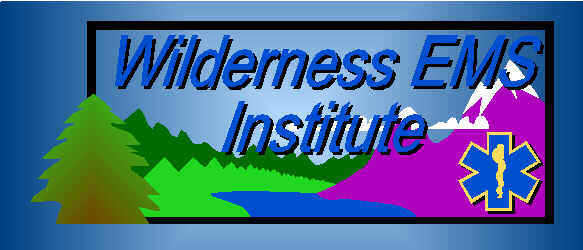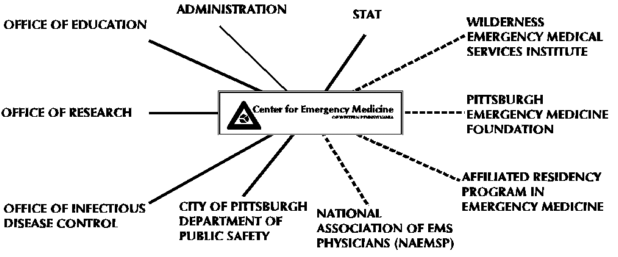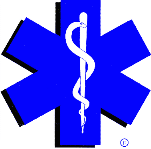

This is a one-sheet, two-page handout on the basics of hypothermia survival for lay, non-SAR audiences. The graphics are by survival education guru and artist Gene Fear and are from older survival texts for which the copyright has expired, and the graphics are now in the public domain. With Acrobat 6 you can export the graphics and use them in your own presentations or handouts.
In 2002, there were more and more paramedics employed in hospitals in Pennsylvania. Members of the EMS Committee drafted a set of questions about this to send to the state EMS office. These questions may be answered at some point, but even as a draft, the set of questions is something worthwhile to look at if you're a paramedic looking at a hospital job, or a hospital looking to employ paramedics.
By clicking this link, you can view a PDF of a document that I use to teach brief wilderness first aid courses. And here is the original Word file. This isn't copyrighted; please use, modify, spindle or mutilate as you wish.
Overcrowded hospitals, overcrowded Emergency Departments, and ambulance diversion are hot topics these days.
The PA State Health Department recently (February 2002) analyzed the problem and came out with a policy on the topic (included as an appendix in the document below). However, if you're trying to develop a policy for your hospital regarding ambulance diversion, there's a paucity of information available. So, with only a slight amount of persuasion, the two state organizations with the most concentrated expertise in this area have agreed to put together a guide for hospitals. It's sort of a tutorial and set of recommendations on how to develop a hospital ambulance policy that works well for the hospital, the hospital's patients, EMS agencies, the EMS agency's patients, and the public as a whole
The two organizations that are developing this document are the EMS Committee of the Pennsylvania Chapter, American College of Emergency Physicians, and the Medical Advisory Committee of the Pennsylvania Emergency Health Services Council. As far as expertise in both EMS and emergency medicine, these two groups of physicians are unparalleled. Needless to say, the top management of each organization will need to approve the document before it's "official."
But, even in draft form, it may be of use to those who have to draft hospital diversion plans now. In addition to being posted here for both PaACEP EMS Committee and PEHSC MAC members to review, both organizations welcome input from anyone who has suggestions for improving the document. We are particularly interested in comments from hospital administrators, ED nurse managers, and those with EMS agencies.
The Hospital Ambulance Diversion Policy document is available in Adobe Acrobat format for quick online viewing.
Please send comments to me.
Thank you.
Don Scelza of WEMSI started putting together a "timeline of Wilderness EMS" for a keynote address he was giving at an EMS conference. And I had to look up some old documents for a wilderness chapter I was writing for the new 2001 edition of the NAEMSP EMS textbook, "Prehospital Systems and Medical Oversight." Well, since we'd gathered this information, it seemed wise to make it public on a web page. Admittedly this is WEMSI-centric, and Don- and Keith-centric, after all we know what we've done better than what others have don, but we welcome contributions from others active in the field. Eventually we'll move this to the WEMSI web page once it looks a bit better.
As time goes on, I will be adding more and more documents and narrative on the history of Wilderness EMS. Because many of the early documents are mimeographed or copied with photocopiers, they are hard to read, and difficult to scan -- not to mention scans taking up a lot of room and being slow to download. Therefore, some of these have been
This retains at least the flavor of the original without much bulk or weight (if you find any major errors please let me know-- however in the NASAR Emergency Medicine Committee, there were several misspellings and such in the original document which should not be corrected).
Mountaineering Freedom of the Hills includes a chapter on First Aid in the mountains
Medicine for Mountaineering first published by The Mountaineers
Feb-83
First, I would like to recognize the early work of Stan G. Bush, who was chairman of the Emergency Medicine Committee of the National Association for Search and Rescue -- in the 1970's, he invested a big part of himself in propelling the idea of what originally was then called Wilderness Medical Technician.
Therefore, the first document is a letter he sent to us, the members of that committee, in order to push the idea and the process of developing a consensus-based, peer-reviewed curriculum for SAR team medical personnel.
Next is a document I prepared for the NASAR Emergency Medicine Committee in 1980, which really didn't go anywhere, but is an interesting reflection of our thinking at the time. I haven't bothered to scan in the latter parts of this document, it's really just a listing of some of the topics of the national EMT-Paramedic curriculum as it existed at the time. Note also that this was before the 1986 survey by WEMSI that determined that SAR teams did NOT want SAR as part of any WMT or WEMT curriculum.
While I had been preparing the above document, Stan Bush had been putting together an outline from all the notes he'd been getting -- he recommended that I pilot my program in the central Appalachian area as planned, and he sent out a document with all the other information he'd put together. Some of the errors are no doubt from the scanning process, others from the original.
But more interesting are the topics -- from my viewpoint now as a physician with long involvement with WEMS, the medical topics sound, well, naive. (They didn't at the time, and spurred my to study hard in medical school.) To look at them now with more medical sophistication, it's like saying that "mountain rescue team members need to know how to accomplish the following types of rescue: 1) easy 2) hard 3) really hard." Nonetheless, this was one of the first curricula of any sort to be published. And it's of great value in showing the state of the art in those days and how we've progressed. (I don't know of any WEMT programs that teach how to do "extended" CPR, for example.)
Unfortunately, the NASAR Emergency Medicine Committee went defunct soon after this, and when resurrected under a new name, was no longer involved in curriculum development. I remember one meeting of this new committee, right after which I quit NASAR. The NASAR board and president wanted the new, much smaller and exclusive Medical Committee to rubber-stamp the (as-yet-incomplete) WEMT curriculum a private contractor was going to teach for NASAR to, among other things, raise money -- the founder of the Wilderness Medical Society walked out of the room saying something to the effect of "both I and the WMS have better things to do than act as a rubber stamp."
Nonetheless, the Wilderness EMT idea probably wouldn't have even have developed if it hadn't been for Stan Bush, Chairman of the NASAR Emergency Medicine Committee in the '70's and 'early '80's and his wide and inclusive committee membership.
Here is the document he produced
Wilderness Medical Society incorporated (Drs. Paul Auerbach, Ed Geehr, Kan Kizer)
Auerbach publishes The Book "Wilderness Medicine - Management of Wilderness and Environmental Emergencies"
Now, on to the seminal documents of the Wilderness EMS Institute (WEMSI). WEMSI was founded in 1985-1986, as a group of volunteers working toward a good SAR team member Wilderness EMT curriculum, which would, it was hoped, serve as an academic backbone for such training nationwide. Originally, WEMSI was called the "Wilderness Emergency Medicine Curriculum Development Project" and these three documents were issued under that name. A packet containing all three of these documents was mailed to every medically-involved SAR organization and SAR-oriented EMS organization we could find. The results from the questionnaire determined WEMSI's direction for the past fifteen years.
Stonehearth Open Learning Opportunities (SOLO) runs first Wilderness First Responder Class
SOLO WEMT Class approved by New Hampshire
Wilderness Medicine Institute incorporated in Colorado by Buck Tilton
In 1995, after several years of work, the EMS Committee (F-30) of ASTM produced standards for the scope of performance of, and the training of, the Wilderness First Responder. ASTM doesn't offer its standards for free, so I can't put them up on the web page or link to them here. However, you can buy a copy from the ASTM web page. The details are here:
ASTM Committee F-30 on Emergency Medical Services. F 1616-95: Standard guide for scope of performance of First Responders who practice in the wilderness, delayed or prolonged transport settings. West
Conshohocken, PA: ASTM, 1995.
ASTM Committee F-30 on Emergency Medical Services. F 1655-95: Standard guide for training First Responders who practice in the wilderness, delayed or prolonged transport settings. West
Conshohocken, PA: ASTM, 1995.
WMS publishes Practice Guidelines for Wilderness Emergency Care
Maryland certifies WEMTs using the WEMSI curriculum
More later.
If you're looking for Wilderness EMT training, but not a SAR team member, or you need EMT training along with the WEMT module, there are many providers of such courses. (Note that WEMSI WEMT classes are offered much less often, and are specifically aimed at SAR team members.) There are many WEMT providers, but the three largest providers of WEMT courses, all with excellent reputations, are:
The curricula offered by all WEMT providers varies -- there is no national standard curriculum for WEMT -- but WEMSI courses, and those offered by the above three providers, are generally similar and of high quality.
My big subspecialty interest is in Wilderness Emergency Medical Services (Wilderness EMS), and I'm the founder and medical director for the Wilderness EMS Institute, and so you might want to check out our WEMSI Web site. Here is a quick-and-dirty explanation of WEMSI:
WEMSI's mission is to improve medical care for people remote from the Emergency Medical Services system. We work for improved Wilderness EMS in three ways: teaching; research; and directly providing Wilderness EMS services. Our teaching activities include providing the curriculum and quality-assurance oversight for classes for field personnel and the physicians who provide medical oversight for them. Organizations offering Wilderness EMT or Wilderness Command Physician classes that follow our entire curriculum, and meet a few quality-control requirements, may register their classes with WEMSI. Participants WEMSI-regcognized classes receive cards and patches from WEMSI. WEMSI does not become involved in the finances of such registered classes.
 We also make our Wilderness
EMT and Wilderness Command Physician curricula available to those who wish to
follow it without registration, or adapt it for their own use. For more information,
please check the WEMSI Web site or request a Wilderness
EMT and Wilderness Command Physician Classes brochure and orderform from the Center for
Emergency Medicine:
We also make our Wilderness
EMT and Wilderness Command Physician curricula available to those who wish to
follow it without registration, or adapt it for their own use. For more information,
please check the WEMSI Web site or request a Wilderness
EMT and Wilderness Command Physician Classes brochure and orderform from the Center for
Emergency Medicine:
Center for Emergency Medicine
230 McKee Place, Suite 500
Pittsburgh, PA 15213-4904
(412) 578-3203
Attn: Pamela Westfall <westfall+@pitt.edu>
WEMSI also sponsors Topics in Wilderness Emergency Medicine, quarterly lectures on wilderness EMS, in the Pittsburgh area.
WEMSI promotes research into topics relevant to the needs of wilderness EMS providers. We also serve as an information resource for physicians and members of search and rescue teams and EMS agencies interested in applying the medical literature to wilderness EMS.
WEMSI is working toward a model Wilderness EMS system in Pennsylvania, Maryland, and other nearby states. We are working with state organizations such as the Pennsylvania Emergency Health Services Council, the Pennsylvania Division of Emergency Medical Services Systems, the Pennsylvania Search and Rescue Council, the Pennsylvania Emergency Management Agency, and the Maryland Institute for Emergency Medical Services Systems.
While working toward such an ideal system, we provide medical oversight to selected Pennsylvania search and rescue teams as an interim model. Our interim Wilderness EMS system in Pennsylvania is parallel and separate from the existing EMS system. But, we support the idea of tightly integrating wilderness EMS with the existing "street" EMS system. In Pennsylvania, WEMSI operates under the broad delegated practice provisions of the Pennsylvania Medical Practice Act, providing sophisticated care beyond the capabilties of the state EMS system. WEMSI is also working closely with Maryland as it develops a formal WEMS system.
WEMSI Wilderness Command Physicians are also available for immediate on-line consultation by local medical control physicians dealing with wilderness medical problems; call the Mercy Hospital Communications Center at 1-800-232-5921.
This is the final draft of a document I was working on for the Pennsylvania Emergency Health Services Council, Medical Advisory Committee. The final version is supposed to be available at the Pennsylvania Emergency Health Services Council (PEHSC) Web site -- as of the end of March 2000, it's missing due to a reorganization of the web site.
However, I've kept the final draft with the redlines here, both because it prints a bit better than the one on the PEHSC site, and so people can see the edits as well -- and until the one at PEHSC is reposted, it's all you get. Click for Adobe Acrobat .pdf of it.
 Click
here or on the icon to read an HTML article about my experiences with, and technical
analysis of, what I think is the best field rewarming device for wilderness EMS and SAR.
Click here to view or download in Adobe Acrobat .PDF
format.
Click
here or on the icon to read an HTML article about my experiences with, and technical
analysis of, what I think is the best field rewarming device for wilderness EMS and SAR.
Click here to view or download in Adobe Acrobat .PDF
format.

Back a couple of years ago, Dr. Bob Desiderio spent a month with me doing a Wilderness EMS elective here in Pittsburgh. At a training session he was running for the local mountain rescue team, someone asked if we could explain exactly what this Center for Emergency Medicine was. While I was hesitating and trying to figure out what to say, Bob said "Wait, I can explain. Have you ever seen an ant farm?" While this gives a good of impression of, well, the kind of impression one gets from the center (the trite phrase "organized chaos" seems to apply) but trying to delve deeper is difficult.
Maybe a diagram would explain better. Click on parts of the diagram to learn more about the Center for Emergency Medicine from a subsidiary page. Click HERE to link directly to the Center's own Web page.


One of the projects I was sucked into, I mean, volunteered for, was revising the Environmental and Rescue sections of the national EMT-Paramedic Curriculum. Officially I'm a "Subject Matter Expert" but there are also Authors, Writing Teams, Garfleblat Supervisors and who knows how many other people involved in this Projects. Nonetheless, and despite some public criticisms along the way, I think the project went quite well and produced a good result. You can visit the Web site and download the final drafts as submitted to NHTSA. You can reach the EMT-P/-I Project at http://www.pitt.edu/~paramed/.
 Back to Keith's Home Page
Back to Keith's Home Page